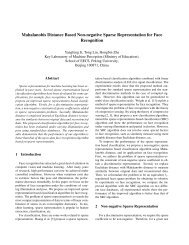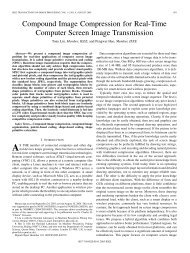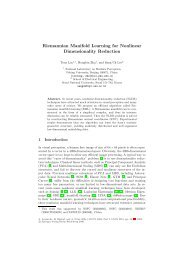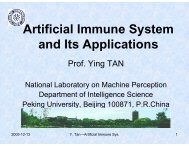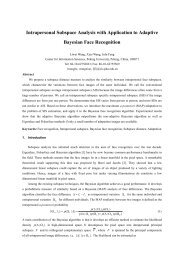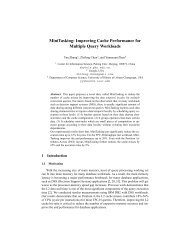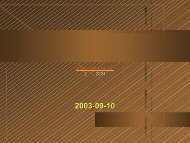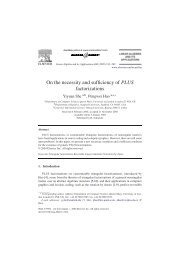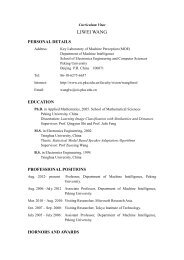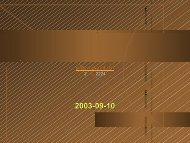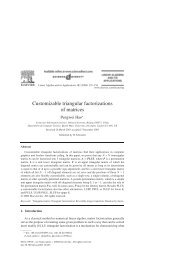monitoring an intersection using a network of laser scanners
monitoring an intersection using a network of laser scanners
monitoring an intersection using a network of laser scanners
You also want an ePaper? Increase the reach of your titles
YUMPU automatically turns print PDFs into web optimized ePapers that Google loves.
MONITORING AN INTERSECTION USING<br />
A NETWORK OF LASER SCANNERS<br />
H. Zhao, J. Cui, H. Zha,<br />
Peking University<br />
K. Katabira, X. Shao, R. Shibasaki,<br />
University <strong>of</strong> Tokyo
Background (1)<br />
Analyzing <strong>an</strong>d Monitoring<br />
the traffic behavior in <strong>an</strong><br />
<strong>intersection</strong><br />
Efficiently <strong>an</strong>d accurately<br />
COLLECTING the TRAFFIC<br />
DATA in <strong>an</strong> INTERSECTION<br />
Real-timely DETECTING<br />
DANGEOUS SITUATIONS.
Background (2)<br />
• Vision-based methods suffer mainly on the<br />
following difficulties<br />
–Occlusion<br />
– Computation Cost<br />
– Illumination Ch<strong>an</strong>ge<br />
To solve the problems<br />
e.g. the camera is<br />
required to be set on a<br />
tall position,<br />
<strong>monitoring</strong> <strong>intersection</strong><br />
from the above<br />
1. Restrict camera’s setting condition<br />
2. Target on a simplified situation<br />
e.g. monitor<br />
vehicles <strong>of</strong><br />
limited l<strong>an</strong>es, do<br />
not discriminate<br />
moving objects.
Objective<br />
This research propose a novel system for<br />
<strong>monitoring</strong> <strong>an</strong>d collecting detailed traffic data,<br />
with easy setting condition, in <strong>an</strong> environment <strong>of</strong><br />
complicated traffic behavior, such as <strong>intersection</strong>,<br />
<strong>using</strong> a <strong>network</strong> <strong>of</strong> single-row <strong>laser</strong> sc<strong>an</strong>ner.
Pedes.<br />
Car<br />
#1<br />
System Image<br />
Server PC<br />
Bicycle<br />
#2<br />
Car<br />
An image <strong>of</strong> integrated <strong>laser</strong> data<br />
Network<br />
#1<br />
Laser Sc<strong>an</strong>ner<br />
#2<br />
Laser Sc<strong>an</strong>ner
Road<br />
side<br />
LD3<br />
LD1<br />
Road<br />
side<br />
LD1<br />
Safety<br />
zone<br />
Safety<br />
zone<br />
LD2<br />
Integrated frame<br />
Single <strong>laser</strong> frame<br />
LD3<br />
10m<br />
Single <strong>laser</strong> frame<br />
LD2<br />
Single <strong>laser</strong> frame
Client<br />
Processing Flow<br />
Laser Sc<strong>an</strong>ner1<br />
Measure data<br />
Laser Sc<strong>an</strong>ner N<br />
Measure data<br />
BG Generation<br />
BG Subtraction<br />
…<br />
BG Generation<br />
BG Subtraction<br />
Clustering<br />
Clustering<br />
Network<br />
Server<br />
1. Data Integration<br />
2. Detection<br />
3. Tracking<br />
4. Recognition<br />
Moving object
Processing Modules<br />
Server<br />
Network<br />
Recognition<br />
Tracking<br />
Detection<br />
Data Integration<br />
Clustering<br />
Moving object<br />
Calibration, Synchronization<br />
Clustering<br />
BG Generation<br />
BG Subtraction<br />
BG Generation<br />
BG Subtraction<br />
Client<br />
Measure Data<br />
Laser Sc<strong>an</strong>ner 1<br />
…<br />
Measure Data<br />
Laser Sc<strong>an</strong>ner N
Server<br />
Recognition<br />
Frame k<br />
Tracking<br />
Detection<br />
Data Integration<br />
trajectory<br />
state<br />
group<br />
observation<br />
Network<br />
Clustering<br />
cluster<br />
BG Generation<br />
BG Subtraction<br />
Client<br />
Measure Data<br />
LD1 LD2 LD3<br />
Data Structure
Difficulties
Difficulty 1
The data <strong>of</strong> the same object might be spatially disconnected
Difficulties
The data <strong>of</strong> different objects might be spatially close<br />
There are different kinds <strong>of</strong> objects, complicated motions
Task 1<br />
We are not able to rely only on dist<strong>an</strong>ce,<br />
size, shape, location etc for detection<br />
<strong>an</strong>d traction.<br />
We need to find some other clues to<br />
associate the data <strong>of</strong> the same object<br />
together.
Data Feature<br />
A car<br />
s<br />
e<br />
u1<br />
c<br />
u2
Data Feature<br />
v4<br />
u<br />
u<br />
u<br />
u<br />
v3<br />
v1<br />
u<br />
u<br />
u<br />
v2
Data Feature<br />
u<br />
u<br />
u<br />
u<br />
u<br />
u
Object Model<br />
(c, val)<br />
(v3, sv3)<br />
u<br />
(v4, sv4)<br />
p<br />
(v2, sv2)<br />
dirv<br />
u<br />
len2<br />
(v1, sv1)<br />
len1<br />
(v1=dirv)
Difficulty 2<br />
The current<br />
frame<br />
The previous<br />
frame<br />
More sensors bring more confusion in data association
Task 2<br />
Data association is difficult when facing a<br />
complicated environment such as <strong>an</strong><br />
<strong>intersection</strong>, where different kinds <strong>of</strong> objects,<br />
different motion patterns exist.<br />
Also, a large number <strong>of</strong> distributed sensors will<br />
bring more difficulties in data association.<br />
A data association algorithm is required to tackle<br />
the confusions.
A r<strong>an</strong>ge stream<br />
Sc<strong>an</strong> <strong>an</strong>gle (within a <strong>laser</strong> sc<strong>an</strong>)<br />
a static object<br />
a moving object<br />
Time (A stream <strong>of</strong> <strong>laser</strong> sc<strong>an</strong>s)
A simple clustering result<br />
Time (A stream <strong>of</strong> <strong>laser</strong> sc<strong>an</strong>s)<br />
Sc<strong>an</strong> <strong>an</strong>gle (within a <strong>laser</strong> sc<strong>an</strong>)
Data Association Method<br />
k-1 k<br />
trajectory<br />
New trajectory<br />
3<br />
group<br />
2<br />
cluster<br />
1<br />
LD1 LD2 LD3 LD1 LD2 LD3 LD3
Experiment<br />
Laser Sc<strong>an</strong>ner<br />
Video Camera<br />
Sports Center<br />
Peking Univ.<br />
Overhead Bridge<br />
Peking Univ.
40cm<br />
激 光 扫 描 仪
Summary<br />
We propose a novel system for <strong>monitoring</strong> <strong>an</strong>d collecting<br />
detailed traffic data, with easy setting condition, in <strong>an</strong><br />
environment <strong>of</strong> complicated traffic behavior, such as<br />
<strong>intersection</strong>, <strong>using</strong> a <strong>network</strong> <strong>of</strong> single-row <strong>laser</strong> sc<strong>an</strong>ners.<br />
Future Topics<br />
• Accuracy evaluation<br />
• Recognition module<br />
• F<strong>using</strong> <strong>laser</strong> sc<strong>an</strong>ner with video camera



